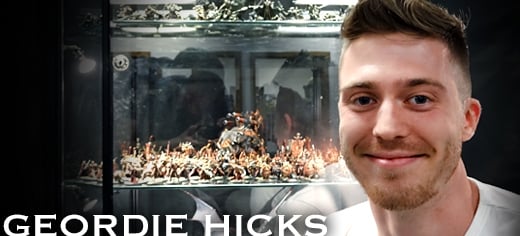
Insider 4-23-2015

Lock & Load GameFest 2014 was my first time as a judge in the P3 Grand Master Competition. Judging over a hundred entries in just a few hours was very challenging—even more so because the judges didn’t always have the same opinions about every model. All the judges brought their own unique ideas to the table, which altered how they viewed the entries in the competition. Despite the subjective nature of the job, though, there are certain things we’re always looking for. This year, I thought it would be helpful to provide some tips to guide aspiring medalists. I should note we don’t judge using points, so these categories are only meaningful in that they all add up to create a finely polished finished product to capture a judge’s attention.

Cleanliness: This can’t be stressed enough. Cleanliness means a solid basecoat, staying in the lines, having the rim of your base painted a solid coat, making sure there are no chips or mold lines, and so on. This is the foundation of every paint job, and it’s important!
Conversions: We don’t specifically judge for conversions, but if you do convert your model, it’s important your conversion is of near-equal quality to the base model. Seeing a rough sculpting transition, or a sculpted piece that is noticeably amateur, can negatively impact an otherwise solid paint job.
Basing: The base of the model should show the same attention to detail as the model itself. Even an immaculately painted model will suffer from a base of plain brown gravel. Make sure the rim of the base is painted. Black tends to work the best for a competition piece because a colored rim draws attention away from your miniature.

Successful use of advanced techniques: There are many different ways to paint models, and some techniques are more difficult to achieve than others. The more difficult the technique used, the more likely it is to draw the attention of the judges. We look for smooth blends, awareness of lighting, contrast, well-executed freehand, composition of the models and their surroundings, and any technique that demonstrates the entrant’s mastery of the hobby.
Colors: Do the colors match? Are they jarring, or are they cohesive? Does the model exhibit a solid understanding of color theory?

Ingenuity: We are always looking for creative and inspiring interpretations of models. All other things being equal, a model in the tried-and-true studio scheme will rank slightly below a model of equal quality in an alternative color scheme. What makes your model stand out from the pack?

Models intended for competition: Often there is a very visible difference between models meant for the game table and those painted with competition in mind. Competition-specific models aren’t constrained to using a gaming base, so you have a lot more leeway to get creative. They are not handled in regular gameplay, so they can be more delicate. Often, competition pieces allow painters to establish an atmosphere or tell a story with a model. These details can add a lot to the impact of your creation.
This may seem like a long list of considerations, but don’t be intimidated. Even high-level painters rarely do perfect in all the categories I mentioned above. These are simply guidelines to help you improve your chances of attaining victory this year. We like to see painters of all skills levels entering the competition. Painting is a journey; it’s not about the destination, it’s about the path. (Cue wise-sounding bamboo flute music here.)
—Geordie
P.S. The two tips we gave most to competition entrants last year were to black line the transitions between sections of a model and to increase the contrast between shadows and highlights. Little details like these can make the difference between a bronze and a silver medal!
Lock & Load 2015 Insiders
![]()
